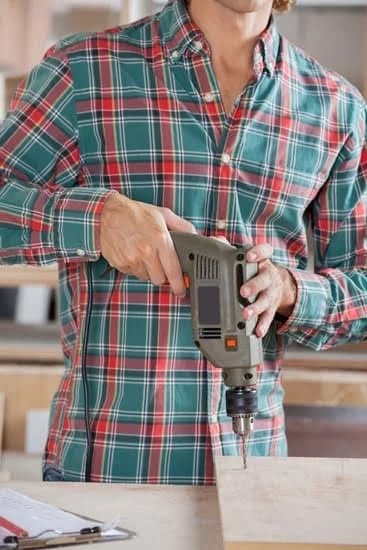Woodworking projects require precision and attention to detail, especially when it comes to calculating angles. In this article, we will delve into the importance of accurate angle measurement in woodworking and explore the challenges that woodworkers often face in this area. By understanding the significance of calculating angles, you can enhance the quality and precision of your woodworking projects.
Accurate angle measurement is essential for successful woodworking projects for several reasons. First and foremost, precise angles ensure that the pieces fit together perfectly, resulting in clean joints and seamless connections. Whether you’re building a piece of furniture or constructing a wooden structure, precise angle calculation is crucial for stability and durability.
However, calculating angles can be challenging for many woodworkers. Common mistakes include inaccurate measurements, misinterpretation of tool readings, or simply not knowing which tool to use for specific angle calculations. Understanding these challenges is vital to overcome them and achieve accurate angle measurements in your woodworking projects.
In the following sections of this article, we will explore the basic tools used for angle measurement in woodworking and discuss their advantages and applications. Additionally, we will dive into different angle measurement systems such as degrees, radians, and fractions. Finally, we will provide a step-by-step guide on how to calculate angles for woodworking projects using both hand tools and digital resources. Stay tuned to master the art of precise angle calculation in woodworking.
Basic Tools for Angle Measurement in Woodworking
Woodworking requires precise angle measurement to ensure accurate and successful projects. To achieve this, woodworkers rely on a variety of basic tools specifically designed for angle measurement. These tools include protractors, angle finders, and bevel gauges, each with their own unique uses and advantages.
One of the most commonly used tools in woodworking is the protractor. This simple yet versatile tool allows woodworkers to measure angles ranging from 0 to 180 degrees. Protractors typically consist of a circular or semicircular shape with marked increments along the edge, making it easy to align with an object or surface. Woodworkers can then read the measurement where the protractor intersects with the object being measured.
Another valuable tool for measuring angles in woodworking is the angle finder. Angle finders are often used to measure angles that aren’t easily accessible or visible. These tools have a hinge mechanism that allows them to adapt to various surfaces and shapes, providing accurate measurements in tight corners or uneven areas. They also feature a locking mechanism that securely holds the desired angle measurement for easy reference during cutting or shaping.
In addition to protractors and angle finders, bevel gauges are particularly useful when working with angled cuts and joints. Bevel gauges are adjustable tools that allow woodworkers to precisely measure and replicate angles on both flat surfaces and edges. By adjusting the gauge’s blade to match an existing angle or desired cut, woodworkers can accurately transfer measurements onto their workpiece without guesswork.
Choosing the right angle measurement tool depends on factors such as project requirements, accessibility, and personal preference. It’s essential for woodworkers to familiarize themselves with these basic tools and understand their individual advantages in order to accurately calculate angles for different woodworking situations.
Understanding Different Angle Measurement Systems
In woodworking, understanding different angle measurement systems is essential for accurate and precise calculations. Woodworkers often encounter various angle measurement systems, such as degrees, radians, and fractions, each with its own advantages and applications within woodworking projects.
Degrees
Degrees are the most familiar and commonly used unit of measurement for angles in woodworking. A full circle is divided into 360 degrees, with each degree further divided into minutes (‘), and seconds (“). Degrees provide a straightforward way to measure angles and are easily understood by woodworkers of all levels. They are particularly useful for measuring angles on straight cuts, bevels, or miter cuts.
Radians
Radians are another unit of measurement for angles that woodworkers may encounter. Unlike degrees, radians measure angles using a radius rather than a circle circumference. Radians can be beneficial when working with circular or curved shapes in woodworking projects. While radians may seem more complex than degrees, they offer advantages in mathematical calculations involving trigonometric functions.
Fractions
In some cases, woodworkers may need to measure angles using fractional units such as 1/4 inch or 1/8 inch increments. Fractional measurements can be suitable for projects requiring precise fraction-based angles such as cabinet making or furniture construction. It is important to note that the use of fractions for angle measurement requires careful interpretation and conversion between fractional units and other systems like degrees or radians.
Understanding the differences between these angle measurement systems allows woodworkers to choose the most appropriate method based on their project requirements. Different tools may also utilize specific measurement systems, so familiarizing oneself with these systems is crucial for accurate calculations and successful woodworking outcomes.
Essential Math Concepts for Angle Calculation
When it comes to calculating angles for woodworking, having a solid understanding of essential math concepts is crucial. These concepts serve as the foundation for accurate angle measurement and help woodworkers achieve precision in their projects. In this section, we will provide a brief overview of some key math principles that are relevant to angle calculation in woodworking.
One important concept in geometry related to angle measurement is the notion of different types of angles. Woodworkers should be familiar with terms such as right angles, acute angles, obtuse angles, and complementary angles. A right angle measures exactly 90 degrees and can be easily recognized as the shape of a perfectly squared corner.
Acute angles measure less than 90 degrees and are commonly found in many woodworking designs. Obtuse angles, on the other hand, measure more than 90 degrees and can add visual interest to projects. Complementary angles are two angles that add up to 90 degrees when combined.
In addition to understanding the types of angles, woodworkers should also be familiar with geometric principles such as parallel lines, perpendicular lines, and intersecting lines. These concepts come into play when measuring and cutting angled joints or creating geometric patterns within woodworking projects. By having a solid grasp of these math concepts, woodworkers can make accurate calculations and ensure that their angles are precise.
To summarize, having a basic understanding of essential math concepts is essential for successful angle calculation in woodworking. Concepts such as different types of angles and geometric principles provide the necessary knowledge to accurately measure and cut wood at specific angles. By mastering these math concepts, woodworkers can enhance the overall quality and precision of their projects.
Key Takeaways
- Understanding different types of angles (right angles, acute angles, obtuse angles) is important for accurate angle calculation in woodworking.
- Knowledge of geometric principles like parallel lines and perpendicular lines helps ensure precise measurements.
- Having a solid grasp of essential math concepts enhances the overall quality and precision of woodworking projects.
Step-by-Step Guide on How to Calculate Angles for Woodworking
Calculating angles accurately is crucial for successful woodworking projects. Whether you’re building furniture, constructing cabinets, or creating intricate designs, having precise angles is essential for achieving the desired outcome. In this section, we will provide a step-by-step guide on how to calculate angles for woodworking.
- Determine the Type of Angle: The first step is to identify the type of angle you need to measure. There are three main types of angles in woodworking: acute angles (less than 90 degrees), right angles (exactly 90 degrees), and obtuse angles (greater than 90 degrees). Once you know the type of angle you’re working with, you can proceed with measuring it.
- Select the Right Tool: Depending on the complexity of your project and the angle you’re measuring, different tools may be more suitable for accurate calculations. For simple angles, a protractor or combination square can be used. If you’re dealing with more complex angles like compound or miter angles, an adjustable bevel gauge or digital angle finder may be required.
- Align the Tool: Once you have selected the appropriate tool, align it with one side of the angle that needs to be measured. Ensure that it is securely held in place so that there is no movement during the measurement process.
- Read and Record the Angle Measurement: Look at the measurement scale on your tool and determine the angle based on where it aligns with the other side of your angle. Take note of this measurement as it will be needed for accurate cutting or assembly later in your project.
- Double-check Accuracy: After obtaining your initial measurement, it’s important to double-check its accuracy to avoid any errors. Use another tool or method to confirm your measurement before proceeding further.
- Apply Angle Calculation: Once you have obtained and confirmed your angle measurement, incorporate it into your woodworking project accordingly. This could involve cutting wood at a specific degree using a miter saw, aligning pieces at the correct angle for joinery, or creating angled joints with precision.
By following these step-by-step instructions, you can ensure that your angle calculations are accurate and precise. Remember to always measure twice and cut once to avoid any costly mistakes in your woodworking projects.
Troubleshooting Common Angle Calculation Issues
Woodworking projects often require precise angle calculations to achieve accurate and seamless results. However, woodworkers may encounter various challenges and errors when calculating angles. This section will address some common angle calculation issues and provide practical tips and techniques for overcoming them.
One common challenge that woodworkers face is inaccurate measurements caused by human error or poorly calibrated tools. It is essential to double-check measurements and ensure that the tools used for angle calculation are properly calibrated. Using high-quality measuring tools such as protractors, angle finders, and bevel gauges can help minimize measurement errors. Additionally, regularly calibrating these tools will ensure accurate readings.
Another issue that woodworkers might encounter is difficulty in determining angles in complex or irregular projects. In such cases, it can be helpful to break down the project into smaller sections or components with simpler angles that are easier to calculate. By dividing the project into manageable parts, woodworkers can accurately measure individual angles before fitting them together.
Furthermore, inconsistent grain patterns in wood can pose a challenge when calculating angles for woodworking. Wood grain can affect the visual appearance of an angle as well as its actual measurement due to its inherent natural variation. To mitigate this issue, it is advisable to mark key reference points directly on the wood’s surface instead of relying solely on visual assessment.
In summary, troubleshooting common angle calculation issues in woodworking requires attention to detail, proper tool calibration, breaking down complex projects into manageable sections, and addressing inconsistencies caused by grain patterns. By being aware of these potential challenges and implementing effective solutions, woodworkers can achieve more accurate angle calculations and improve the overall quality of their woodworking projects.
| Common Angle Calculation Issues | Troubleshooting Tips |
|---|---|
| Inaccurate measurements | – Double-check measurements
|
| Determining angles in complex projects | – Break down the project into smaller sections
|
| Inconsistent grain patterns | – Mark key reference points directly on the wood’s surface
|
Practical Examples and Applications of Angle Calculation in Woodworking
Angle calculation is a crucial skill in woodworking, as it determines the accuracy and precision of various cuts and joints. By understanding how to calculate angles effectively, woodworkers can enhance the overall quality of their projects. In this section, we will explore some practical examples and applications where accurate angle calculation plays a crucial role.
- Angled Joints: One common application of angle calculation in woodworking is creating angled joints. These joints are used to connect two pieces of wood at an angle other than 90 degrees. For example, when constructing a picture frame with mitered corners, accurate angle measurement ensures that each corner fits perfectly together for a clean and seamless finish.
- Beveled Edges: Another practical application of angle calculation is creating beveled edges on wooden surfaces. Beveling involves cutting or shaping the edge of a board at an angle other than 90 degrees. This technique is commonly used to create decorative edges on furniture, cabinets, or moldings. Accurate angle calculation ensures that each bevel cut matches the desired angle precisely.
- Compound Angles: In more complex woodworking projects such as building stairs or constructing roof trusses, compound angles come into play. Compound angles involve multiple simultaneous tilts or rotations across different planes. For instance, when building stairs with balustrades, accurate angle calculation ensures that each stair tread aligns correctly with the balusters while maintaining the desired pitch and levelness.
To successfully execute these applications and achieve desired results, woodworkers need to accurately measure angles using appropriate tools like protractors or digital measuring devices. Additionally, it is essential to understand geometry principles related to angles such as right angles (90 degrees), acute angles (less than 90 degrees), obtuse angles (greater than 90 degrees), and complementary angles (when two angles add up to 90 degrees).
By mastering the art of calculating angles, woodworkers can take their projects to the next level, achieving precise cuts and flawless joinery. The ability to accurately calculate angles enhances craftsmanship, ensures structural integrity, and elevates the aesthetic appeal of the finished piece. Whether it’s creating angled joints, beveled edges, or dealing with compound angles, accurate angle calculation is an indispensable skill for every woodworker.
Advanced Techniques
Calculating Compound and Miter Angles in woodworking can be a more advanced and complex process compared to basic angle measurements. Understanding these techniques is crucial for successfully completing more intricate woodworking projects, such as creating frames or constructing furniture with precise joints. In this section, we will delve into the intricacies of calculating compound and miter angles, providing step-by-step instructions and tips for precise measurement and cutting.
Compound Angles
Compound angles involve the combination of two different angles to create a single cut on a piece of wood that has multiple dimensions or planes. This technique is commonly used when creating angled joints or corners in projects like staircases or cabinet doors. To calculate compound angles accurately, it is important to follow these steps:
- Determine the Angle of One Plane: Measure and mark the desired angle on one plane or face of the wood using an appropriate measuring tool. Ensure that you are measuring either an acute angle (less than 90 degrees) or an obtuse angle (greater than 90 degrees), as compound angles are not applicable for right angles.
- Determine the Second Plane’s Angle: Identify the second plane where the two pieces of wood will join or intersect. Measure and mark the desired angle on this plane using the same measuring tool used in step 1.
- Calculate Both Angles Simultaneously: Combine both angles by adding them together to find the compound angle needed for accurate cutting. For example, if one plane has an angle of 30 degrees and the other has an angle of 45 degrees, then the compound angle would be 75 degrees.
- Set Up Your Tools: Use a compound miter saw or a sliding bevel gauge to set up your tools based on the calculated compound angle.
Miter Angles
Miter angles are commonly used when creating clean and seamless joints at corners in woodworking projects, such as picture frames or door frames. Unlike compound angles, miter angles involve making cuts perpendicular to each other. To calculate miter angles precisely, follow these steps:
- Determine the Corner Angle: Measure and mark the corner angle where the two pieces of wood will join. Use a protractor or an appropriate measuring tool to accurately measure the angle.
- Halve the Corner Angle: Divide the corner angle in half by dividing it by This will give you the miter angle required for cutting.
- Set Up Your Tools: Use a miter saw or a miter gauge on a table saw to set up your tools based on the calculated miter angle.
Remember, precision is key when calculating and cutting compound and miter angles in woodworking projects. It’s always recommended to practice on scrap wood before moving on to your actual project, as slight inaccuracies can affect the fit and overall appearance of joints. Additionally, having reliable measuring tools with clear and accurate markings is essential for achieving precise results in your woodworking endeavors.
Recommended Tools and Resources for Angle Calculation in Woodworking
Woodworking requires precise and accurate angle measurement in order to achieve successful outcomes. To ensure that angles are calculated correctly, it is important for woodworkers to have the right tools and resources at their disposal. This section will provide recommendations for essential tools and resources that can aid in angle calculation for woodworking projects.
When it comes to tools for angle measurement in woodworking, there are several options available. One of the most common tools is a protractor, which is a semi-circular tool with degree markings that allows woodworkers to measure angles accurately. Protractors come in various sizes and materials, such as plastic or stainless steel, providing different levels of durability and accuracy.
Another useful tool for angle measurement is an angle finder. Angle finders often consist of two arms connected by a hinge, allowing woodworkers to adjust the arms to various angles. Some angle finders also include a level feature or digital display for more precise measurements.
Bevel gauges are another valuable tool for measuring angles in woodworking. These gauges typically consist of a handle attached to an adjustable blade that can be set at different angles. Bevel gauges are commonly used when transferring angles from one piece of wood to another during joinery work or creating angled cuts.
In addition to these basic tools, there are also online resources, apps, and software available that can assist woodworkers in calculating angles accurately. These resources often provide virtual protractors or digital angle finders that can be accessed through smartphones or computers. They may also include additional features such as advanced calculations or project-specific recommendations.
By utilizing recommended tools and resources for angle calculation in woodworking, woodworkers can enhance their precision and efficiency in their projects. Having access to accurate tools like protractors, angle finders, and bevel gauges ensures that angles are measured correctly from the start, minimizing errors and rework later on.
Additionally, leveraging online resources or apps can provide further assistance in complex angle calculations or offer additional guidance specific to the project at hand. With the right tools and resources, woodworkers can confidently tackle any woodworking project requiring angle measurement.
Conclusion
In conclusion, mastering angle calculation is crucial for woodworking success. Accurate angle measurement is essential in ensuring precise and high-quality woodworking projects. Throughout this article, we have explored the significance of calculating angles in woodworking and highlighted the challenges and common mistakes that woodworkers often face when it comes to angle measurement.
We have learned about the basic tools for angle measurement in woodworking, such as protractors, angle finders, and bevel gauges. These tools offer precision and accuracy in calculating angles, allowing woodworkers to achieve the desired results in their projects. Understanding different angle measurement systems, including degrees, radians, and fractions, further enhances our ability to calculate angles effectively.
Moreover, we have discussed essential math concepts related to angle calculation, such as right angles, acute angles, obtuse angles, and complementary angles. By familiarizing ourselves with these concepts, we can confidently approach angle measurement in woodworking tasks.
To help readers further develop their skills in angle calculation for woodworking projects, we have provided a step-by-step guide on how to calculate angles using both hand tools and digital resources. This guide breaks down the process into simple and easy-to-follow steps.
We have also addressed common challenges faced by woodworkers when calculating angles and offered practical tips and techniques for overcoming measurement errors or inconsistencies. By troubleshooting these issues effectively, woodworkers can ensure accurate angle calculation throughout their projects.
Lastly, we have showcased practical examples and applications of accurate angle calculation in real-life woodworking scenarios. From constructing furniture to building intricate wooden structures, knowing the right angles significantly enhances the overall quality and precision of every project.

Hi everyone! I’m a woodworker and blogger, and this is my woodworking blog. In my blog, I share tips and tricks for woodworkers of all skill levels, as well as project ideas that you can try yourself.





